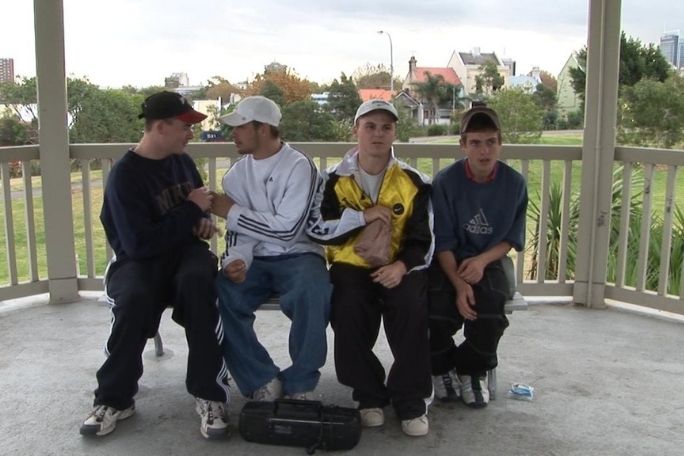Lesson summary
Students explore and compare the relationship between empathetic response, personal values and social action. In a free-writing exercise, they consider their own view of the issue of homelessness and contrast it with their analysis of the viewpoint put forward in Ben Harper’s song ‘Homeless Child’. Students then find and view three sections from THE OASIS that highlight the manner in which Paul Moulds engages with those around him, and work collaboratively to create a mind map that outlines the influence of Paul on the people he engages with. Students create a bio-poem that further explores Paul Moulds, his approach to his work and life, and the effect that he has on those who encounter him.
Key ideas to explore:
- Representations of social issues can be used to either engender or confront attitudes and values.
- The relationship between empathetic response, values and social action.
Lesson guides and printables
Lesson details
Curriculum mapping
Australian curriculum content descriptions:
Year 9 English:
- Interpret, analyse and evaluate how different perspectives of issue, event, situation, individuals or groups are constructed to serve specific purposes in texts (ACELY1742)
- Explore and explain the combinations of language and visual choices that authors make to present information, opinions and perspectives in different texts (ACELY1745)
- Create imaginative, informative and persuasive texts that present a point of view and advance or illustrate arguments, including texts that integrate visual, print and/or audio features (ACELY1746)
Year 10 English:
- Identify and analyse implicit or explicit values, beliefs and assumptions in texts and how these are influenced by purposes and likely audiences (ACELY1752)
- Use comprehension strategies to compare and contrast information within and between texts, identifying and analysing embedded perspectives, and evaluating supporting evidence (ACELY1754)
- Create sustained texts, including texts that combine specific digital or media content, for imaginative, informative, or persuasive purposes that reflect upon challenging and complex issues (ACELY1756)
Year 11 English:
- analysing how language choices are made for different purposes and in different contexts using appropriate metalanguage; for example, personification, voice-over, flashback, salience (ACEEN002)
- evaluating the impact of description and imagery, including figurative language, and still and moving images in digital and multimodal texts (ACEEN007)
- purpose, taking into account that a text’s purpose is often open to debate (ACEEN008)
- combining visual, spoken and written elements where appropriate (ACEEN013)
- investigating the impact and uses of imaginative, interpretive and persuasive texts (ACEEN020)
- analysing the ways language features, text structures and stylistic choices shape points of view and influence audiences (ACEEN024)
- evaluating the effects of rhetorical devices, for example, emphasis, emotive language and imagery in the construction of argument (ACEEN025)
- analysing how attitude and mood are created, for example, through the use of humour in satire and parody (ACEEN027)
- using imaginative, interpretive and persuasive elements for different purposes, contexts and audiences (ACEEN032)
- experimenting with text structures, language features and multimodal devices (ACEEN033)
Year 12 English:
- analysing language, structural and stylistic choices (ACEEN041)
- making innovative and imaginative use of language features (ACEEN051)
- using and experimenting with text structures and language features related to specific genres for particular effects (ACEEN052)
- undertaking close analysis of texts (ACEEN060)
- analysing content, purpose and choice of language (ACEEN063)
- exploring other interpretations and aspects of context to develop a considered response (ACEEN065)
- the ways points of view and values are represented (ACEEN067)
- using appropriate language and stylistic features to sustain a personal voice and point of view (ACEEN069)
Syllabus Outcomes: EN5-1A, EN5-2A, EN5-8D.
General capabilities: Critical and Creative Thinking, Ethical Understanding, Literacy.
Unit of work: THE OASIS – English
Time required: 60 minutes
Level of teacher scaffolding: Medium – facilitate discussion.
Resources required
- Student Worksheet – one copy per student OR computers/tablets to access the online worksheet
- Device capable of presenting a website to the class
- Access to THE OASIS documentary on Vimeo. Bubble.us, mindmeister or similar to display students’ ideas.
Additional Info
This resource has been adapted from ‘Teaching Social Issues Through English’ developed with the English Teachers Association NSW and the ‘Youth Homelessness Matters Resource’ developed by Janice Atkin. You can find these resources here.


Welcome back!
Don't have an account yet?
Log in with:
By signing up to Cool.org you consent and agree to Cool's privacy policy to
store, manage and process your personal information. To read more, please see
our privacy policy here(Opens in new tab).
Create your free Cool.org account.
Many of our resources are free, with an option to upgrade to Cool+ for premium content.
Already have an account?
Sign up with:
By signing up to Cool.org you consent and agree to Cool's privacy policy to
store, manage and process your personal information. To read more, please see
our privacy policy here(Opens in new tab).